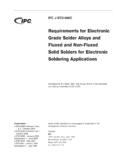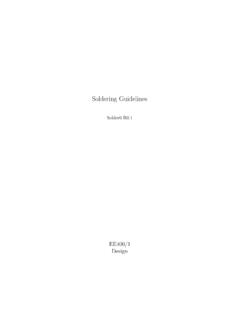Transcription of Wave Soldering Troubleshooting Guide
1 Wave Soldering Troubleshooting GuideAIM s Practical SolutionsExcellence is more than a ,AIMhasevolvedfromhumblebeginningsintoan internationalleaderinthedevelopment, , , ,consistencyandvaluethroughouttheentirep rocess,withproductsandservicesdeliveredl ocally,andyetstillinspiredbyaglobal, , , ,RickBlackPresident,AIMit s our passionTypes of Wave Soldering DefectsTypes of DefectsNon-WettingDewettingPin HolesWebbingWhite HazeSolder BallsIcyclingBridgingExcess SolderDull/Grainy JointsCold/Disturbed JointsNon-WettingRecognized by pull back of solder to expose the surface that was to be solderedNon-WettingPossible Causes:Grease, oil or dirt on the pre-soldered surfaceBleeding or misregistered solder maskLow temperature solderContaminated solderSurfaces too heavily oxidized for flux being usedContaminated fluxPoor application of fluxRemedy:Investigate each possible cause and correct suspected discrepancies one at a timeuntil solderability is restoredDewettingRecognized by metal wetting initially, then pulling back to form droplets of solder on the surfaceDewettingPossible Causes:Contamination of surface by abrasivesPoor platingPoor hot air solder leveling during PCB manufacturingRemedy:Restore solderability of the surfacePin HolesRecognized by small holes or eruptions in the solder filletPin HolesPossible Causes:Moisture or plating solution in the PCB laminateInadequate preheat to evaporate flux solventFlux has absorbed waterPhysical blockage due to foreign body in holeTop of plated through hole prematurely solidifyingRemedy.
2 Increase preheat to see if it eliminates problemPut in new flux to see if it eliminates problemIncrease topside preheat and/or solder temperature to correct premature topside plated through hole freezingIf all of these fail, have the PCB s baked and cross sectionedWebbingRecognized by a spider web like extension of solder across the nonconductive portion of the PCBW ebbingPossible Causes:Improper curing of the laminate or solder maskInadequate flux (when accompanied by bridging or icycling)Dross in the solder waveRemedy:Baking the PCB will sometimes correct the improperly cured mask or laminate conditionSubstituting a more viscous flux or increasing the quantity of flux put on the PCBC orrecting the drossingproblem in the waveWhite Haze on Solder MaskRecognized by a white haze on the nonconductive portion of the PCB that cannot be removed by Haze on Solder MaskPossible Causes:Improper curing of the laminate or solder maskRemedy:Baking the PCB will sometimes correct the improperly cured mask or laminate conditionSolder BallsRecognized by tiny spherical shapes of solder dispersed over the surface of the PCBS older BallsPossible Causes:Insufficient preheatPlated through hole conditions that create pin holes, resulting in Solder BallsHigh Humidity in the manufacturing areaMoisture in the fluxRemedy:Investigate each possible cause and correct suspected discrepancies one at a timeuntil problem is correctedIcyclingRecognized by conical or flag shaped extension of the solder filletIcyclingPossible Causes:Any condition that causes the solder to solidify while in the process of draining, such as:Inadequate flux to promote quick drainagePot temperature too lowSoldering surface unusually heat absorbentLeads picking up dross in the waveWrong plated through hole to wire ratioRemedy.
3 Investigate each possible cause and correct suspected discrepancies one at a timeuntil problem is correctedBridgingRecognized by solder extending from one lead to an adjacent lead, causing a short circuitBridgingPossible Causes:Component leads that are bent or too closely spacedExcess solderInadequate flux remains to promote drainageBoard immersed too deep in the waveLeads picking up dross in the waveContaminated solderPoor component solderabilityRemedy:Investigate each possible cause and correct suspected discrepancies one at a timeuntil problem is correctedExcess SolderRecognized by:Bulbous appearance of filletUnable to see contours of lead and landExcess SolderPossible Causes:Any condition that contributes to poor drainage of the solderLow temperature of solder or preheatContamination of solderInsufficient flux to promote drainageIncorrect wave exit angle or speedRemedy:Investigate each possible cause and correct suspected discrepancies one at a timeuntil problem is correctedDull or Grainy JointsRecognized by dark, non reflective, rough surfaces from an alloy that is normally bright and shinyDull or Grainy JointsRemedies:Determine if the alloy typically has a shiny surface finishExamine a recent pot analysis or have one completedConduct electrical and mechanical evaluation to see if rework is necessaryIf solder meets J-STD-006 purity standards and joints are mechanically sound, there is no reason for rejection or touch upIf solder does not meet standard, it is a cold jointand should be replacedCold or Disturbed JointsRecognized by rough and dull finish on the fillets in conjunction with unacceptable mechanical strength of the jointCold or Disturbed JointsPossible Causes:Movement while joint is still molten caused by.
4 Conveyor mechanism erraticSolder temperature too highRemedy:Look for causes of vibration being transmitted to the PCB and correct themEnsure that solder reaches solidus temperature immediately after joint is completedAIM Global LocationsThank YouRevision A











